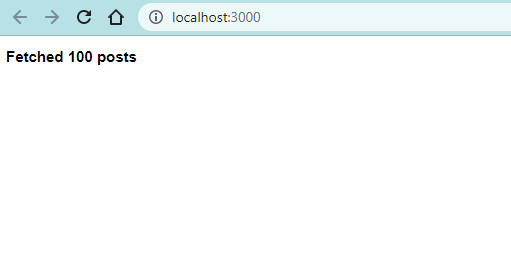Making API Requests in React
By Hemanta Sundaray on 2022-07-31
If your React app needs to fetch data from an API endpoint, then you have to make a HTTP request. In React apps we make HTTP requests using something called a HTTP client.
In this post, we will learn how to use a Promise based HTTP client called axios.
To make HTTP requests, you can also make use of the Fetch API built into most modern browsers.
Using Axios
Install axios using npm install axios and import it at the top of your React project.
Now let’s use axios to make a GET request and fetch some posts from JSON Placeholder, which is a free fake REST API service for testing and prototyping purposes. We will make the request to the /posts endpoint, which will return to us an array of 100 posts.
Understand that making a network request is an asynchronous operation. Therefore, it will take some amount of time for axios to reach out to the JSONPlaceholder API and fetch the response. So we will handle the Promise object returned from the execution of this asynchronous operation using async...await.
Learn more about Promise and async/await in my blog post here.
import React from "react";
import axios from "axios";
const Posts = () => {
const fetchPosts = async () => {
const response = await axios.get(
"https://jsonplaceholder.typicode.com/posts"
);
console.dir(response);
};
return <button onClick={fetchPosts}>Fetch Posts</button>;
};
export default Posts;When I click on the FetchPosts button, the response gets logged to the console.
We can see that the data we care about (posts) is the value of the data key inside the request object.
Setting State After Async Requests
After we get the response back, we can set state in our React component.
import React, { useState } from "react";
import axios from "axios";
const Posts = () => {
const [posts, setPosts] = useState([]);
const fetchPosts = async () => {
const { data } = await axios.get(
"https://jsonplaceholder.typicode.com/posts"
);
setPosts(data);
};
return (
<>
<button onClick={fetchPosts}>Fetch Posts</button>
<h2>
Fetched {posts.length > 0 ? posts.length : 0} post
{posts.length > 0 ? "s" : ""}
</h2>
</>
);
};
export default Posts;Now, let’s say we want to fetch posts (only once) when the Posts component renders. We don’t want to press any button to fetch posts.
Then, we will have to make the request inside useEffect().
Learn more about the useEffect() hook in my blog post here.
import React, { useState, useEffect } from "react";
import axios from "axios";
const Posts = () => {
const [posts, setPosts] = useState([]);
useEffect(() => {
const fetchPosts = async () => {
const { data } = await axios.get(
"https://jsonplaceholder.typicode.com/posts"
);
setPosts(data);
};
fetchPosts();
}, []);
return (
<h2>
Fetched {posts.length > 0 ? posts.length : 0} post
{posts.length > 0 ? "s" : ""}
</h2>
);
};
export default Posts;Creating Custom Clients
We can shorten the code we have written for making network requests using axios inside the Posts component by creating a custom client.
import axios from "axios";
// Create a new instance of axios
export default axios.create({
baseURL: "https://jsonplaceholder.typicode.com",
});import React, { useState, useEffect } from "react";
import fakeApi from "./api/FakeApi";
const Posts = () => {
const [posts, setPosts] = useState([]);
useEffect(() => {
const fetchPosts = async () => {
const { data } = await fakeApi.get("/posts");
setPosts(data);
};
fetchPosts();
}, []);
return (
<h2>
Fetched {posts.length > 0 ? posts.length : 0} post
{posts.length > 0 ? "s" : ""}
</h2>
);
};
export default Posts;

